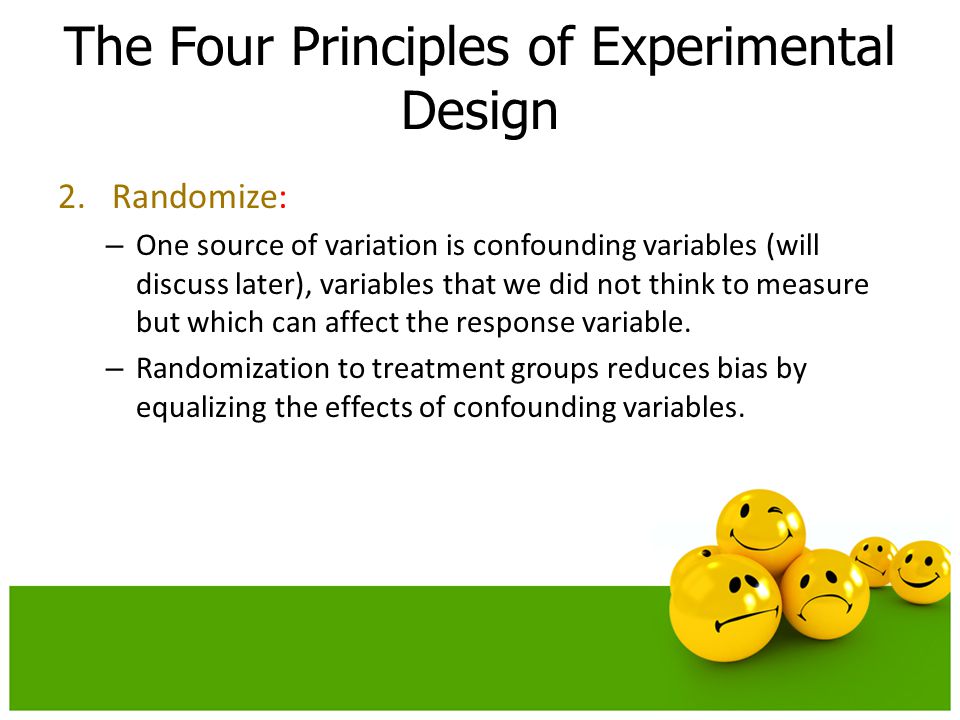Describe the Four Principles of Experimental Design
One-shot Case Study Experimental Research Design. Four Principles of Experimental Design 1.

Types Of Experimental Designs 3 3 Youtube
Design of experiment provides a method by which the treatments are placed at random on the experimental units in such a way that the responses are estimated with the utmost precision possible.

. The first principle of an experimental design is randomization which is a random process of. Goal make groups so they are as similar as possible at beginning of study 3. In this type of experimental study only one dependent group or variable is considered.
This is the most commonly used method implemented in Physical Science. Latin Square Design De nition A Latin square design is a design in which three explanatory variables typically one treatment and two blocking each of which is categorical with the same number of levels in this example four so that each pair of variables has the same number of observations for each possible pair of levels. Randomly assign subjects to treatment groups.
Allows us to equalize the effects of unknown or uncontrollable sources of variation. Principles of experiment design. Click here to download or print the Study Guide for this section and use it to take notes as you follow along with the videos in this section.
101 GENERAL PRINCIPLES OF EXPERIMENTAL DESIGN Experimental design is a term describing the logical structure of an experiment. Professor Fisher has enumerated three principles of experimental designs. E a multistage sample.
B a categorical variable. D a matched pairs design. Pre-experimental design quasi experimental design true experimental design one shot case design one group pretest- posttest design features manipulation of independent variables limited control over the extraneous variables no randomization and control group non randomized block design time series design features manipulation of.
The Principle of Replication. Write a specific testable hypothesis. C a block design.
Principles of experimental design 1. The 4 steps of using the experimental research design are. The pre-experimental research design is further divided into three types.
Defining Research Questions and variable. There are three basic principles of design which were developed by Sir Ronald A. The principle of replication.
A good experimental design requires a strong understanding of the system you are studying. Click here to drop us a line. Terms in this set 4 Control.
Let us begin by defining some of the terms that are commonly used in discussions of experimental design. A footwear company wants to test the effectiveness of its new insoles designed to prevent shin splints resulting from running. 206 Three Principles of Experimental Design.
One-shot Case Study Research Design. Which of the following is not one of the four principles of experimental design. Professor Fisher has enumerated three principles of experimental designs.
The essential difference between an experiment and an observational study is a observational studies may have. Design experimental treatments to manipulate your independent variable. One-group Pretest-posttest Experimental Research Design.
The second principle of an experimental design is replication which is a repetition of the basic. Consider your variables and how they are related. Ø Single treatment does not produce variations in the results.
In this video I discuss the four principles for an effective experimental design. Use chance to assign experimental units to treatments to roughly equivalent groups by balancing effects of other variables among groups. It is very much essential for you to address knowledge gaps.
Replication Ø The repetition of the treatments under the investigation is called replication. Thus each treatment is applied in many experimental units instead of one. The study is carried out after some treatment which was presumed to cause change making it a posttest study.
This allows us to equalize the effects of unknown or uncontrollable sources of variation. Statistical Issues in Experimental Design Sample size Affects Precision in estimation Power Effect size Meaningful results Power Experimental design isolation of important variables alpha Sample size Measurement error Probability of type one error Correct Decision Prejecting HoHa1- b Power Mistake Type I Error PIa. 2 or more treatments 2.
113 The Four Principles of Experimental Design 1. Ø They are classically called the Principles of Experimental Design they are. Wed love to hear how you are using TEAs Study Edge instructional resources.
Researchers require spending time reading about related to your field of study. The Principle of Randomization. They hire a group of physical trainers and a statistician who recruits healthy adults between the ages of and to participate in a study.
The statistician randomly assigns of the adults. Control sources of variation other than the factors being tested by making conditions as similar as possible for all treatment groups. Experimental designs are now used in almost all the areas of scientific studies.
-A control group serves as a reference mark for an actual treatment to be compared control variables so all subjects are tested in similar circumstances. AP Stats summary questions. There are five key steps in designing an experiment.
The experiment should be reaped more than once. How to use experimental Research Design. Block The Best Experiments Are randomized.
You need to consider research Questions. The important point is that if you are talking to a statistician. And the Principle of Local Control.
Principles of experimental design. A a completely randomized design. This is the most accurate form of experimental research design as it relies on the statistical hypothesis to prove or disprove the hypothesis.
This opens in a new window.

Experiments And Observational Studies Ppt Download

No comments for "Describe the Four Principles of Experimental Design"
Post a Comment